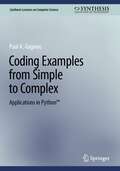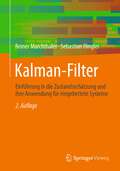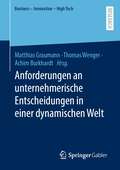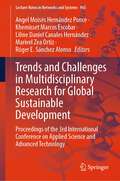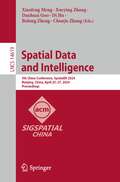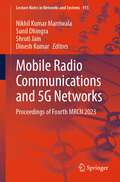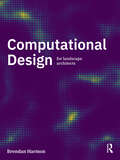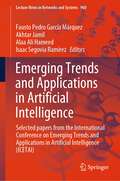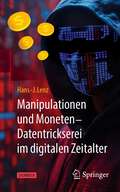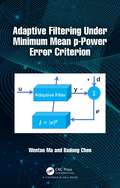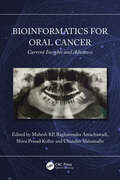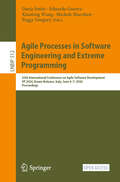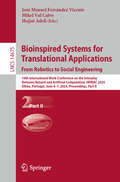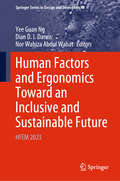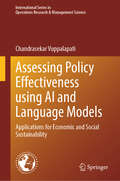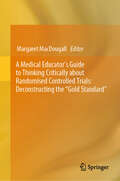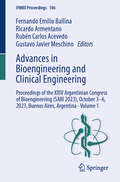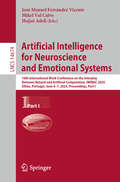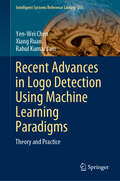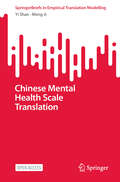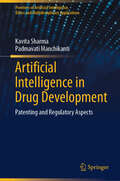- Table View
- List View
Coding Examples from Simple to Complex: Applications in Python™ (Synthesis Lectures on Computer Science)
by Paul A. GagniucThis book provides a comprehensive guide to Python, which stands as the cornerstone of modern programming and is the main computer language driving software prototyping in both industry and research. The author introduces readers to the rich world of Python, taking them on a journey from the fundamentals to advanced topics, equipping them with the knowledge and skills needed to become a proficient Python developer or scientist. The book provides a treasure trove of practical examples, meticulously crafted to deepen the reader understanding of Python. This comprehensive exploration is designed to cater to novice learners as well as mature developers and scientists, equipping them with the requisite knowledge and competencies to harness the Python full potential in their respective projects. From the basics of variable naming and program structure to complex matrix operations, recursion, and object-oriented programming, this book covers it all. This book is part of a seriesof works designed to present both the examples and their explanations in various computer languages, as close to a mirror version as possible.
Kalman-Filter: Einführung in die Zustandsschätzung und ihre Anwendung für eingebettete Systeme
by Reiner Marchthaler Sebastian DinglerDieses Lehrbuch befasst sich leicht verständlich mit der Theorie der Kalman-Filterung. Die Autoren geben damit eine Einführung in Kalman-Filter und deren Anwendung für eingebettete Systeme. Zusätzlich wird anhand konkreter Praxisbeispiele der Kalman-Filterentwurf demonstriert – Teilschritte werden im Buch ausführlich erläutert.Kalman-Filter sind die erste Wahl, um Störsignale auf den Sensorsignalen zu eliminieren. Dies ist von besonderer Bedeutung, da viele technische Systeme ihre prozessrelevanten Informationen über Sensoren gewinnen. Jeder Messwert eines Sensors weißt jedoch aufgrund verschiedener Ursachen einen Messfehler auf. Würde ein System nur auf Basis dieser ungenauen Sensorinformationen arbeiten, so wären viele Anwendungen, wie zum Beispiel ein Navigationssystem oder autonome arbeitende Systeme, nicht möglich.Das Buch ist geeignet für interessierte Bachelor- und Master-Studierende der Fachrichtungen Informatik, Maschinenbau, Elektrotechnik undMechatronik. Ebenso ist das Buch eine Hilfe für Ingenieure und Wissenschaftler, die ein Kalman-Filter z. B. für die Datenfusion oder die Schätzung unbekannter Größen in Echtzeitanwendungen einsetzen möchten.
Anforderungen an unternehmerische Entscheidungen in einer dynamischen Welt (Business - Innovation - High Tech)
by Matthias Graumann Achim Burkhardt Thomas WengerUnternehmerische Entscheidungen profitieren vom Rückgriff auf wissenschaftliches Wissen. Es leitet nicht nur das methodische Vorgehen beim Treffen von Entscheidungen an, sondern stellt auch konkrete Ursache-Wirkungs-Beziehungen zur Verfügung. Auf diese Weise unterstützt die Wissenschaft die Beantwortung praktischer Fragen, was die Autoren dieses Sammelbandes anhand zahlreicher Beispiele aus Organisation, Führung und Marketing illustrieren.
Trends and Challenges in Multidisciplinary Research for Global Sustainable Development: Proceedings of the 3rd International Conference on Applied Science and Advanced Technology (Lecture Notes in Networks and Systems #965)
by Angel Moisés Hernández Ponce Khemisset Marcos Escobar Liline Daniel Canales Hernández Marivel Zea Ortiz Róger E. Sánchez AlonsoSince its beginning the International Conference on Applied Sciences and Advanced Technology (ICASAT) was planned as a multidisciplinary space and as a platform to explore the frontiers of knowledge in different areas such as Machine Vision, Biotechnology, Computer Sciences, Mechatronics and, Sustainability. Also, a multidisciplinary perspective is required in all aspects of science, engineering, and research, moving towards a more complete overview of recent advances. On its third edition, ICASAT received works focused on the Trends and Challenges for Global Sustainable Development. This book is a collection of the works presented during ICASAT 2023.
Spatial Data and Intelligence: 5th China Conference, SpatialDI 2024, Nanjing, China, April 25–27, 2024, Proceedings (Lecture Notes in Computer Science #14619)
by Xiaofeng Meng Xueying Zhang Bolong Zheng Danhuai Guo Di Hu Chunju ZhangThis book constitutes the refereed post proceedings of the 5th China Conference on Spatial Data and Intelligence, SpatialDI 2024, held in Nanjing, China, during April 25–27, 2024. The 25 full papers included in this book were carefully reviewed and selected from 95 submissions. They were organized in topical sections as follows: Spatiotemporal Data Analysis, Spatiotemporal Data Mining, Spatiotemporal Data Prediction, Remote Sensing Data Classification and Applications of Spatiotemporal Data Mining.
Mobile Radio Communications and 5G Networks: Proceedings of Fourth MRCN 2023 (Lecture Notes in Networks and Systems #915)
by Dinesh Kumar Shruti Jain Nikhil Kumar Marriwala Sunil DhingraThis book features selected high-quality papers from the Forth International Conference on Mobile Radio Communications and 5G Networks (MRCN 2023), held at University Institute of Engineering and Technology, Kurukshetra University, Kurukshetra, India, during August 25–26, 2023. The book features original papers by active researchers presented at the International Conference on Mobile Radio Communications and 5G Networks. It includes recent advances and upcoming technologies in the field of cellular systems, 2G/2.5G/3G/4G/5G, and beyond, LTE, WiMAX, WMAN, and other emerging broadband wireless networks, WLAN, WPAN, and various home/personal networking technologies, pervasive and wearable computing and networking, small cells and femtocell networks, wireless mesh networks, vehicular wireless networks, cognitive radio networks and their applications, wireless multimedia networks, green wireless networks, standardization of emerging wireless technologies, power management and energy conservation techniques.
The French School of Programming
The French School of Programming is a collection of insightful discussions of programming and software engineering topics, by some of the most prestigious names of French computer science. The authors include several of the originators of such widely acclaimed inventions as abstract interpretation, the Caml, OCaml and Eiffel programming languages, the Coq proof assistant, agents and modern testing techniques.The book is divided into four parts: Software Engineering (A), Programming Language Mechanisms and Type Systems (B), Theory (C), and Language Design and Programming Methodology (D). They are preceded by a Foreword by Bertrand Meyer, the editor of the volume, a Preface by Jim Woodcock providing an outsider’s appraisal of the French school’s contribution, and an overview chapter by Gérard Berry, recalling his own intellectual journey. Chapter 2, by Marie-Claude Gaudel, presents a 30-year perspective on the evolution of testing starting with her own seminal work. In chapter 3, Michel Raynal covers distributed computing with an emphasis on simplicity. Chapter 4, by Jean-Marc Jézéquel, former director of IRISA, presents the evolution of modeling, from CASE tools to SLE and Machine Learning. Chapter 5, by Joëlle Coutaz, is a comprehensive review of the evolution of Human-Computer Interaction. In part B, chapter 6, by Jean-Pierre Briot, describes the sequence of abstractions that led to the concept of agent. Chapter 7, by Pierre-Louis Curien, is a personal account of a journey through fundamental concepts of semantics, syntax and types. In chapter 8, Thierry Coquand presents “some remarks on dependent type theory”. Part C begins with Patrick Cousot’s personal historical perspective on his well-known creation, abstract interpretation, in chapter 9. Chapter 10, by Jean-Jacques Lévy, is devoted to tracking redexes in the Lambda Calculus. The final chapter of that part, chapter 11 by Jean-Pierre Jouannaud, presents advances in rewriting systems, specifically the confluence of terminating rewriting computations. Part D contains two longer contributions. Chapter 12 is a review by Giuseppe Castagna of a broad range of programming topics relying on union, intersection and negation types. In the final chapter, Bertrand Meyer covers “ten choices in language design” for object-oriented programming, distinguishing between “right” and “wrong” resolutions of these issues and explaining the rationale behind Eiffel’s decisions.This book will be of special interest to anyone with an interest in modern views of programming — on such topics as programming language design, the relationship between programming and type theory, object-oriented principles, distributed systems, testing techniques, rewriting systems, human-computer interaction, software verification… — and in the insights of a brilliant group of innovators in the field.
Computational Design for Landscape Architects
by Brendan HarmonThis book is a guide to computational design for landscape architects replete with extensive tutorials. It introduces algorithmic approaches for modeling and designing landscapes. The aim of this book is to use algorithms to understand and design landscape as a generative system, i.e. to harness the processes that shape landscape to generate new forms. An algorithmic approach to design is gently introduced through visual programming with Grasshopper, before more advanced methods are taught in Python, a high-level programming language. Topics covered include parametric design, randomness and noise, waves and attractors, lidar, drone photogrammetry, point cloud modeling, terrain modeling, earthworks, digital fabrication, and more. The chapters include sections on theory, methods, and either visual programming or scripting. Online resources for the book include code and datasets so that readers can easily follow along and try out the methods presented. This book is a much-needed guide, both theoretical and practical, on computational design for students, educators, and practitioners of landscape architecture.
Computational Design for Landscape Architects
by Brendan HarmonThis book is a guide to computational design for landscape architects replete with extensive tutorials. It introduces algorithmic approaches for modeling and designing landscapes. The aim of this book is to use algorithms to understand and design landscape as a generative system, i.e. to harness the processes that shape landscape to generate new forms. An algorithmic approach to design is gently introduced through visual programming with Grasshopper, before more advanced methods are taught in Python, a high-level programming language. Topics covered include parametric design, randomness and noise, waves and attractors, lidar, drone photogrammetry, point cloud modeling, terrain modeling, earthworks, digital fabrication, and more. The chapters include sections on theory, methods, and either visual programming or scripting. Online resources for the book include code and datasets so that readers can easily follow along and try out the methods presented. This book is a much-needed guide, both theoretical and practical, on computational design for students, educators, and practitioners of landscape architecture.
Emerging Trends and Applications in Artificial Intelligence: Selected papers from the International Conference on Emerging Trends and Applications in Artificial Intelligence (ICETAI) (Lecture Notes in Networks and Systems #960)
by Fausto Pedro García Márquez Akhtar Jamil Alaa Ali Hameed Isaac Segovia RamírezThe book covers the proceedings of the International Conference on Emerging Trends and Applications in Artificial Intelligence (ICETAI) held at Istanbul Medipol University, Turkey, on 24 – 25 August 2023. It presents a comprehensive compilation of papers covering the forefront of artificial intelligence, encapsulating state-of-the-art models, innovative methodologies applied to benchmark datasets, and incisive analyses addressing contemporary challenges. Encompassing four pivotal tracks—Artificial Intelligence and Machine Learning, Big Data and Cloud Computing, Internet of Things and Sensor Technology, and Applications of Artificial Intelligence—this volume serves as a vital resource for researchers, scholars, and professionals navigating the multifaceted landscape of AI advancements and their real-world applications across diverse domains.
Manipulationen und Moneten – Datentrickserei im digitalen Zeitalter
by Hans-J. LenzSchummeln ist neben Schwindeln mit Sicherheit Teil menschlichen Lebens. Es fängt schon im Kindergarten an mit Klauen von Spielsachen oder von Süßigkeiten. In der Schule wird abgeschrieben oder es werden Spicker benutzt. In der Berufswelt eröffnet die digitale Welt neue Möglichkeiten und berührt alle Lebensbereiche. Datenbetrug zielt auf geldliche Vorteile und Prestige ab oder wird vom Hass getrieben. Seine gesamte Breite wird sachlich vorgestellt und begründet, jedoch so, dass in vielen Fällen noch Schmunzeln über Einfallsreichtum und Tricksereien der Datenbetrüger möglich ist.Der Begriff Datenbetrug ist umfassend und reicht von A (Arzt im Profisport) bis Z (Zocken beim Fußball). Er ist nicht ausschließlich juristisch zu sehen, sondern ist ein gesellschaftlich-wirtschaftliches Phänomen jeder zivilisierten Gesellschaft. Die digitale Welt mit ihren virtuellen Räumen eröffnet allen Unredlichen künftig ganz neue, beängstigende Perspektiven.
Adaptive Filtering Under Minimum Mean p-Power Error Criterion
by Badong Chen Wentao MaAdaptive filtering still receives attention in engineering as the use of the adaptive filter provides improved performance over the use of a fixed filter under the time-varying and unknown statistics environments. This application evolved communications, signal processing, seismology, mechanical design, and control engineering. The most popular optimization criterion in adaptive filtering is the well-known minimum mean square error (MMSE) criterion, which is, however, only optimal when the signals involved are Gaussian-distributed. Therefore, many "optimal solutions" under MMSE are not optimal. As an extension of the traditional MMSE, the minimum mean p-power error (MMPE) criterion has shown superior performance in many applications of adaptive filtering. This book aims to provide a comprehensive introduction of the MMPE and related adaptive filtering algorithms, which will become an important reference for researchers and practitioners in this application area. The book is geared to senior undergraduates with a basic understanding of linear algebra and statistics, graduate students, or practitioners with experience in adaptive signal processing.Key Features: Provides a systematic description of the MMPE criterion. Many adaptive filtering algorithms under MMPE, including linear and nonlinear filters, will be introduced. Extensive illustrative examples are included to demonstrate the results.
Adaptive Filtering Under Minimum Mean p-Power Error Criterion
by Badong Chen Wentao MaAdaptive filtering still receives attention in engineering as the use of the adaptive filter provides improved performance over the use of a fixed filter under the time-varying and unknown statistics environments. This application evolved communications, signal processing, seismology, mechanical design, and control engineering. The most popular optimization criterion in adaptive filtering is the well-known minimum mean square error (MMSE) criterion, which is, however, only optimal when the signals involved are Gaussian-distributed. Therefore, many "optimal solutions" under MMSE are not optimal. As an extension of the traditional MMSE, the minimum mean p-power error (MMPE) criterion has shown superior performance in many applications of adaptive filtering. This book aims to provide a comprehensive introduction of the MMPE and related adaptive filtering algorithms, which will become an important reference for researchers and practitioners in this application area. The book is geared to senior undergraduates with a basic understanding of linear algebra and statistics, graduate students, or practitioners with experience in adaptive signal processing.Key Features: Provides a systematic description of the MMPE criterion. Many adaptive filtering algorithms under MMPE, including linear and nonlinear filters, will be introduced. Extensive illustrative examples are included to demonstrate the results.
Bioinformatics for Oral Cancer: Current Insights and Advances
Amid the rising global concern of oral cancer, this book provides a compelling exploration of the intricate oral cavity, focused on shedding light on early diagnosis and addressing outdated paradigms, it delves into the persistent challenges of oral premalignant lesions. Tailored for both beginners and researchers, its six chapters encompass the spectrum of genome sequencing, diagnostic biomarkers, gene expression, and more. Discover a fusion of basic and clinical sciences, aiming to invigorate the study of bioinformatics and oral cancer, and ultimately improve survival rates.Bioinformatics for Oral Cancer: Current Insights and Advances serves as a comprehensive guide, offering a deep dive into the multifaceted landscape of oral cancer research and bioinformatics. Within its pages, readers will uncover a wealth of knowledge, starting with foundational chapters introducing bioinformatics and establishing the backdrop of oral cancer. The book then progresses into the realm of diagnostic biomarkers, revealing cutting-edge methodologies for their identification in the context of oral cancer. The book’s keen focus extends to gene expression profiles and the intricacies of gene sequencing in the context of oral cancer progression. By systematically unravelling these critical aspects, the book bridges the gap between basic and clinical sciences, equipping readers with a holistic understanding of bioinformatics’ pivotal role in enhancing our grasp of oral cancer’s complexities.By deciphering the enigmatic landscape of oral premalignant lesions, the book equips clinicians and researchers with tools to predict malignant potentials. Its meticulous exploration of gene expression profiles and sequencing promises to reshape early detection strategies, propelling the field towards improved diagnosis and treatment outcomes.
Bioinformatics for Oral Cancer: Current Insights and Advances
by Raghavendra Amachawadi Shiva Prasad Kollur Chandan Shivamallu Mahesh KpAmid the rising global concern of oral cancer, this book provides a compelling exploration of the intricate oral cavity, focused on shedding light on early diagnosis and addressing outdated paradigms, it delves into the persistent challenges of oral premalignant lesions. Tailored for both beginners and researchers, its six chapters encompass the spectrum of genome sequencing, diagnostic biomarkers, gene expression, and more. Discover a fusion of basic and clinical sciences, aiming to invigorate the study of bioinformatics and oral cancer, and ultimately improve survival rates.Bioinformatics for Oral Cancer: Current Insights and Advances serves as a comprehensive guide, offering a deep dive into the multifaceted landscape of oral cancer research and bioinformatics. Within its pages, readers will uncover a wealth of knowledge, starting with foundational chapters introducing bioinformatics and establishing the backdrop of oral cancer. The book then progresses into the realm of diagnostic biomarkers, revealing cutting-edge methodologies for their identification in the context of oral cancer. The book’s keen focus extends to gene expression profiles and the intricacies of gene sequencing in the context of oral cancer progression. By systematically unravelling these critical aspects, the book bridges the gap between basic and clinical sciences, equipping readers with a holistic understanding of bioinformatics’ pivotal role in enhancing our grasp of oral cancer’s complexities.By deciphering the enigmatic landscape of oral premalignant lesions, the book equips clinicians and researchers with tools to predict malignant potentials. Its meticulous exploration of gene expression profiles and sequencing promises to reshape early detection strategies, propelling the field towards improved diagnosis and treatment outcomes.
Agile Processes in Software Engineering and Extreme Programming: 25th International Conference on Agile Software Development, XP 2024, Bozen-Bolzano, Italy, June 4–7, 2024, Proceedings (Lecture Notes in Business Information Processing #512)
by Xiaofeng Wang Peggy Gregory Eduardo Guerra Michele Marchesi Darja ŠmiteThis open access book constitutes the proceedings of the 25th International Conference on Agile Software Development, XP 2024, which took place in Bozen-Bolzano, Italy, during June 04-07, 2024. XP is the premier agile software development conference combining research and practice. It is a unique forum where agile researchers, practitioners, thought leaders, coaches, and trainers get together to present and discuss their most recent innovations, research results, experiences, concerns, challenges, and trends. XP conferences provide an informal environment to learn and trigger discussions and welcome both people new to agile and seasoned agile practitioners. This year’s conference was held with the theme “Reflect, Adapt, Envision”. The 10 full and 2 short papers included in these proceedings were carefully reviewed and selected from 32 submissions. They were organized in topical sections as follows: agile at scale; value and quality in agile; and people and teams in agile.
Bioinspired Systems for Translational Applications: 10th International Work-Conference on the Interplay Between Natural and Artificial Computation, IWINAC 2024, Olhâo, Portugal, June 4–7, 2024, Proceedings, Part II (Lecture Notes in Computer Science #14675)
by Hojjat Adeli José Manuel Ferrández Vicente Mikel Val CalvoThe two volume set LNCS 14674 and 14675 constitutes the proceedings of the 10th International Work-Conference on the Interplay Between Natural and Artificial Computation, IWINAC 2024, which took place in Olhâo, Portugal, during June 4–7, 2024. The 99 full papers presented in these proceedings were carefully reviewed and selected from 193 submissions. They were organized in topical sections as follows: Part I: Machine learning in neuroscience; artificial intelligence in neurophysiology; neuromotor and cognitive disorders; intelligent systems for assessment, treatment, and assistance in early stages of Alzheimer's disease and other dementias; socio-cognitive, affective and physiological computing; affective computing and context awareness in ambientintelliigence; learning tools to lecture; Part II: Machine learning in computer vision and robotics; bio-inspired computing approaches; social and civil engineering through human AI translations; smart renewable energies: advancing AI algorithms in the renewable energy industry; bioinspired applications.
Human Factors and Ergonomics Toward an Inclusive and Sustainable Future: HFEM 2023 (Springer Series in Design and Innovation #46)
by Yee Guan Ng Dian D. I. Daruis Nor Wahiza Abdul WahatThis book gathers the refereed proceedings of the 5th HFEM Biennial Conference on Human Factors and Ergonomics, organized by the Human Factors and Ergonomics Society Malaysia, held in Langkawi, Malaysia on August 13–18, 2023. Under the theme "Accelerating Human Factors and Ergonomics Toward an Inclusive and Sustainable Future", it highlights the latest theories and models, as well as cutting-edge technologies and applications on human factors and ergonomics. By combining findings from a range of disciplines including engineering, design, robotics, health care, management, computer science, human biology, and behavioral science, it offers an excellent source of innovative ideas to stimulate future discussions and developments aimed at applying knowledge and techniques to optimize system performance, while at the same time promoting the health, safety, and well-being of individuals. It includes papers from researchers and practitioners, scientists and physicians, institutional leaders, managers, and policy makers that contribute to constructing the human factors and ergonomics approach across a variety of methodologies, domains, and productive sectors.
Assessing Policy Effectiveness using AI and Language Models: Applications for Economic and Social Sustainability (International Series in Operations Research & Management Science #354)
by Chandrasekar VuppalapatiThis volume uses advanced machine learning techniques to analyze government communication to evaluate policy effectiveness. The book develops policy effectiveness foundation models by cohorting historical budget policies with statistical models which are built on well reputed data sources including economic events, macroeconomic trends, and ratings and commerce terms from international institutions. By signal mining policies to the economic outcome patterns, the book aims to create a rich source of successful policy insights in terms of their effectiveness in bringing development to the poor and underserved communities to ensure the spread of wealth, social wellbeing, and standard of living to the common denomination of society rather than a selected quotient. Enabling academics and practitioners across disciplines to develop applications for effective policy interventions, this volume will be of interest to a wide audience including software engineers, data scientists, social scientists, economists, and agriculture practitioners.
A Medical Educator's Guide to Thinking Critically about Randomised Controlled Trials: Deconstructing the "Gold Standard"
by Margaret MacDougallDrawing on the statistical and philosophical expertise of its authors, this book is designed to improve understanding and use of randomised controlled trials (RCTs) among health professionals. It is intended for use primarily by medical educators involved in teaching statistics and evidence-based medicine (EBM) to medical students, junior doctors and other health professionals. However, each of the chapters serves a wider range of interests, including the practical needs of physicians in interpreting research evidence to support clinical decision making and the teaching needs of philosophers of medicine who want to more fully appreciate how RCTs work in practice and provide engaging examples for their students. Rather than compete with the proliferating methodological literature on RCT designs, this book focuses on cultivating a healthy skepticism among developing health professionals to support critical appraisal of their own and published work on RCTs at a fundamental level, including through a more informed understanding of the place of subgroup analyses in sound statistical inference. Management of the positive predictive value in the statistical analysis of RCT findings is included as an important topic for contemporary medical curricula. In comparing RCTs with non-randomised studies, a search for empirical evidence for the superiority of RCTs is initiated, pointing to the need for further work to confirm what form this evidence should take.Medical educators will find a wealth of reasons to encourage their students to think more critically about how the RCT operates in practice as a gold standard.
Advances in Bioengineering and Clinical Engineering: Proceedings of the XXIV Argentinian Congress of Bioengineering (SABI 2023), October 3–6, 2023, Buenos Aires, Argentina - Volume 1 (IFMBE Proceedings #106)
by Ricardo Armentano Fernando Emilio Ballina Rubén Carlos Acevedo Gustavo Javier MeschinoThis book offers a timely snapshot of research, technologies and best practices in the broad area of bioengineering and clinical engineering. It reports on advances in biomechanics, biomedical image processing, biomaterials and tissue engineering. Further, it covers applications of artificial intelligence in biology and medicine, and instrumentation. Gathering the first volume of the proceedings of the XXIV Argentinian Congress of Bioengineering (SABI 2023), held on October 3–6, 2023, in Buenos Aires, Argentina - and organised by the Sociedad Argentina de Bioingeniería, this book provides an extensive source of information for both researchers and professionals in biomedical and clinical engineering.
Artificial Intelligence for Neuroscience and Emotional Systems: 10th International Work-Conference on the Interplay Between Natural and Artificial Computation, IWINAC 2024, Olhâo, Portugal, June 4–7, 2024, Proceedings, Part I (Lecture Notes in Computer Science #14674)
by Hojjat Adeli José Manuel Ferrández Vicente Mikel Val CalvoThe two volume set LNCS 14674 and 14675 constitutes the proceedings of the 10th International Work-Conference on the Interplay Between Natural and Artificial Computation, IWINAC 2024, which took place in Olhâo, Portugal, during June 4–7, 2024. The 99 full papers presented in these proceedings were carefully reviewed and selected from 193 submissions. They were organized in topical sections as follows: Part I: Machine learning in neuroscience; artificial intelligence in neurophysiology; neuromotor and cognitive disorders; intelligent systems for assessment, treatment, and assistance in early stages of Alzheimer's disease and other dementias; socio-cognitive, affective and physiological computing; affective computing and context awareness in ambientintelliigence; learning tools to lecture; Part II: Machine learning in computer vision and robotics; bio-inspired computing approaches; social and civil engineering through human AI translations; smart renewable energies: advancing AI algorithms in the renewable energy industry; bioinspired applications.
Recent Advances in Logo Detection Using Machine Learning Paradigms: Theory and Practice (Intelligent Systems Reference Library #255)
by Yen-Wei Chen Xiang Ruan Rahul Kumar JainThis book presents the current trends in deep learning-based object detection framework with a focus on logo detection tasks. It introduces a variety of approaches, including attention mechanisms and domain adaptation for logo detection, and describes recent advancement in object detection frameworks using deep learning. We offer solutions to the major problems such as the lack of training data and the domain-shift issues. This book provides numerous ways that deep learners can use for logo recognition, including: Deep learning-based end-to-end trainable architecture for logo detection Weakly supervised logo recognition approach using attention mechanisms Anchor-free logo detection framework combining attention mechanisms to precisely locate logos in the real-world images Unsupervised logo detection that takes into account domain-shift issues from synthetic to real-world images Approach for logo detection modeling domain adaption task in the context of weakly supervised learning to overcome the lack of object-level annotation problem. The merit of our logo recognition technique is demonstrated using experiments, performance evaluation, and feature distribution analysis utilizing different deep learning frameworks. The book is directed to professors, researchers, practitioners in the field of engineering, computer science, and related fields as well as anyone interested in using deep learning techniques and applications in logo and various object detection tasks.
Chinese Mental Health Scale Translation (New Frontiers in Translation Studies)
by Meng Ji Yi ShanThis open access book illustrates the key steps and procedures of developing mental health scales into linguistically and culturally appropriate translations. Through illustrative case studies, we demonstrate that traditional forward and backward translation have significant methodological limitations when applied in mental health scale translation, such as linguistic and cultural inaccessibility and inaccuracy in the clinic. Our book will stimulate more academic debates and further systematic research into the significant, interdisciplinary area of mental health translation, which has been underexplored in Translation Studies.
Artificial Intelligence in Drug Development: Patenting and Regulatory Aspects (Frontiers of Artificial Intelligence, Ethics and Multidisciplinary Applications)
by Kavita Sharma Padmavati ManchikantiThis book discusses how Artificial Intelligence developments have revolutionized the area of medicine and how companies use them to develop applications. While the book covers the growth of AI in medicine and the early developments in AI based medical tools, it provides an in-depth analysis of the current developments in relation to the area of medical diagnostics. The book focuses on how enterprises and institutes have developed their intellectual property portfolio, particularly patents, in this area. Cross-country patenting analysis helps in understanding key areas of growth in certain markets and also company strategies and arrangements. The introduction of AI based products in market is subject to regulation. The developments in policy and regulation influence the development and deployment of such products into the market. This book brings focus to the development of policy and regulation and how regulatory developments impact the introduction of AI-based healthcare products from a cross-country perspective. Further, how regulatory developments lead to the evolution of standards, build reliability and safety in this area are also examined. The unique aspect of this book is the comprehensive coverage of the dual aspects of the nature and scope of AI-based innovations in health care and the related drug regulatory aspects which are imperative for the understanding for students, researchers, and those who work in this area.
